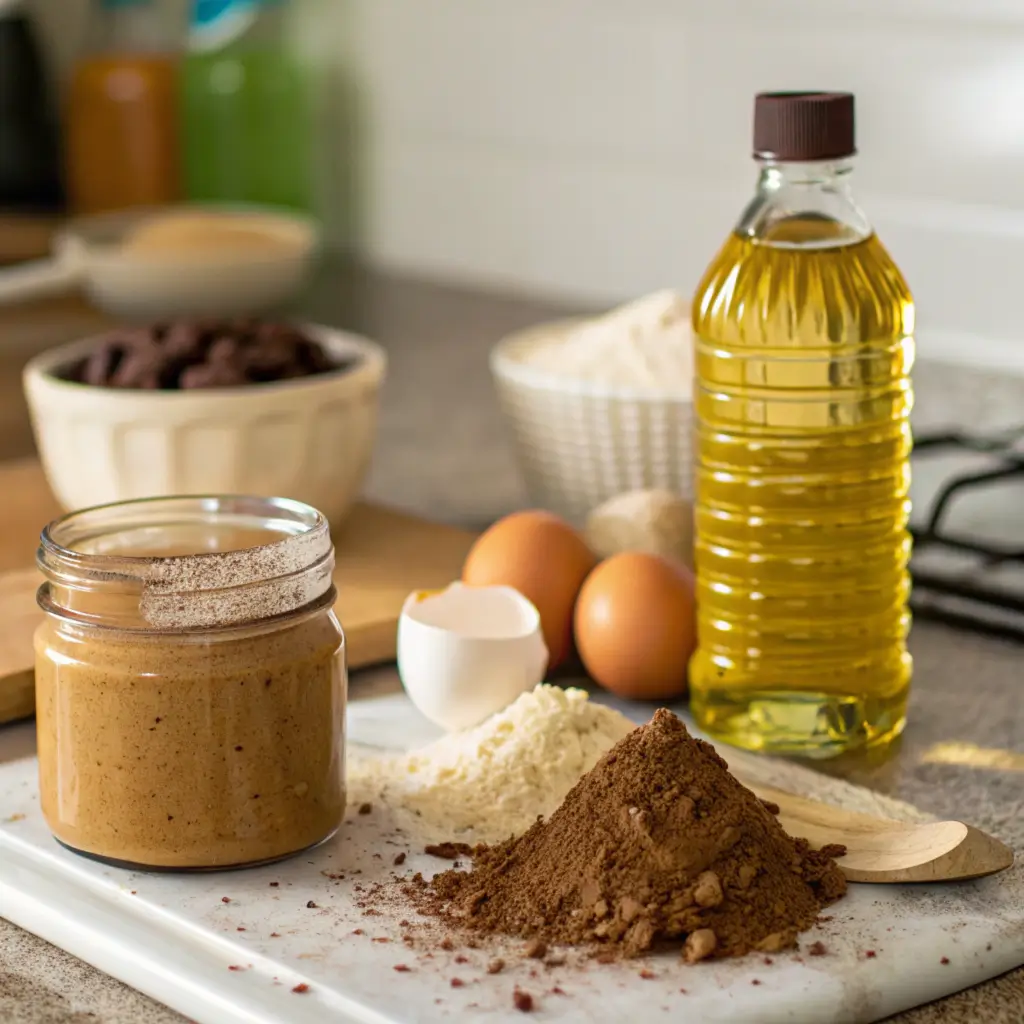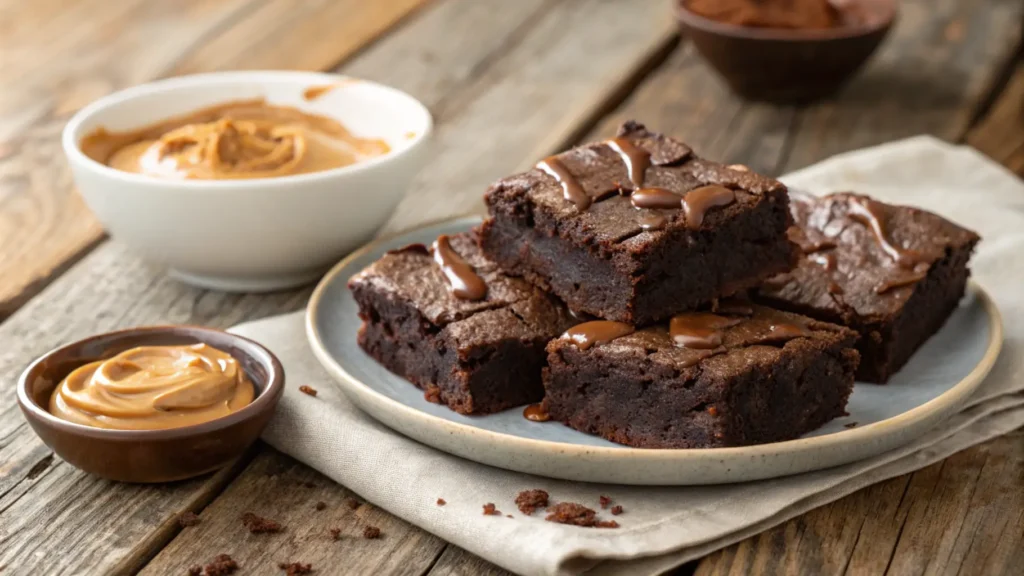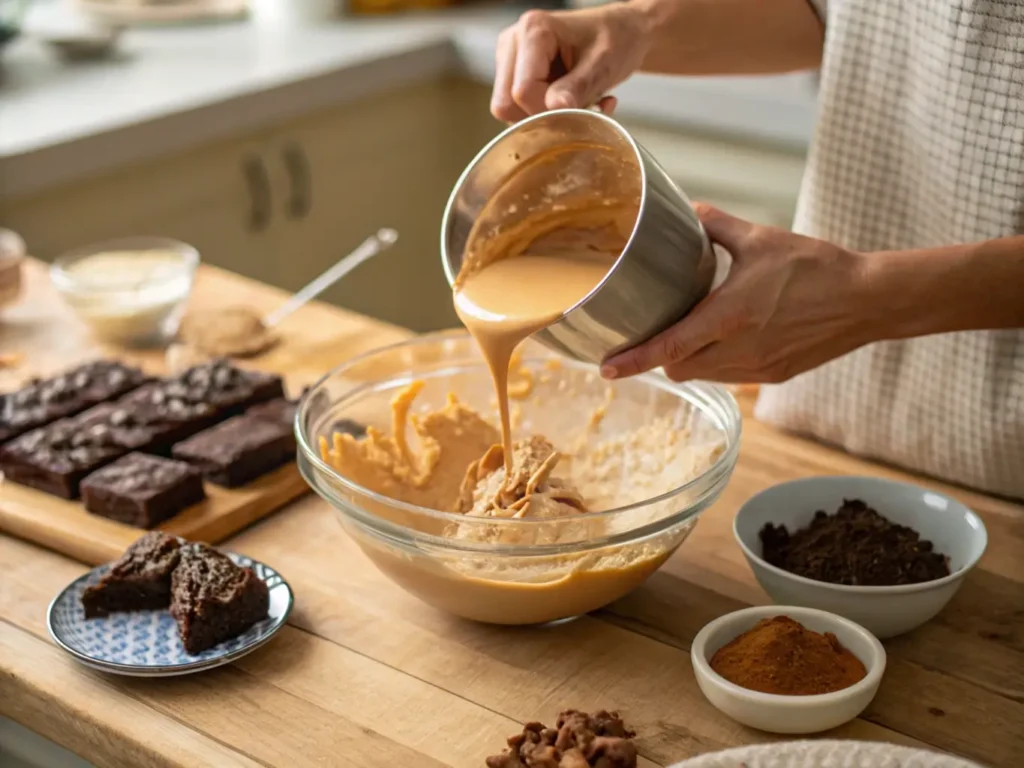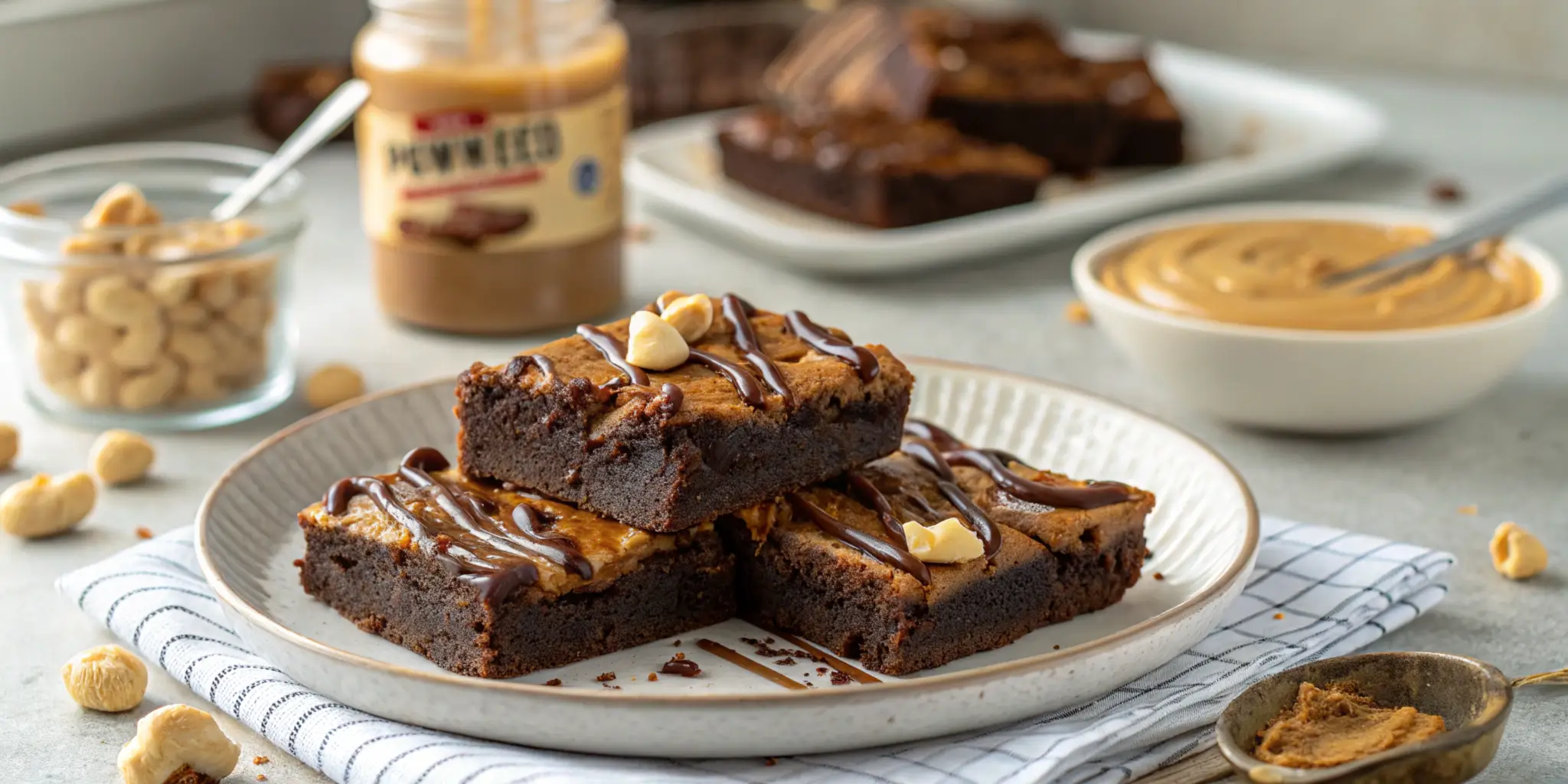Brownies are one of the most beloved desserts, but what if you’re out of oil or looking to try something different? Can I substitute peanut butter for oil in brownies? Absolutely! This swap isn’t just convenient—it adds a nutty flavor and nutritional benefits while still delivering a deliciously moist and chewy texture.
The Function of Oil in Brownie Recipes
Oil plays a crucial role in creating the fudgy, moist texture we all love in brownies. It coats the flour’s protein, preventing it from absorbing too much liquid. This keeps the batter smooth and easy to mix, while also ensuring the brownies don’t become dry or crumbly. Without this moisture, you might end up with a batch of overly dense squares—far from the rich, chewy texture you’d expect.

Moisture and Texture Contributions
Think of oil as the ingredient that gives your brownies their signature softness. It traps air during the mixing process, helping the batter rise slightly as it bakes. When you swap oil for another ingredient like peanut butter, understanding how it affects these dynamics is key to success.
Flavor Profile Impact
Unlike butter, which adds a distinct richness, oil is often flavor-neutral. This allows the chocolate or other added flavors to shine. Replacing oil with peanut butter, however, introduces a nutty undertone that pairs beautifully with cocoa. It’s a subtle change but one that brownie lovers might adore.
Why Consider Peanut Butter as an Oil Substitute?
Many people ask, “Can I substitute peanut butter for oil in brownies?” The answer is yes, and it’s a great choice for those who want to add a unique flavor while making their dessert slightly healthier.
Using peanut butter as a replacement for oil in brownies isn’t just about convenience. It’s also a way to introduce a unique flavor and improve the nutritional profile of your dessert. Peanut butter is rich in healthy fats, protein, and essential vitamins like Vitamin E. Compared to oil, it adds more body to the batter, resulting in brownies with a slightly denser texture but a satisfyingly creamy mouthfeel.
Moreover, it’s an excellent option for those looking to cut back on processed oils or add a twist to a classic recipe. The subtle nuttiness complements the chocolate flavor beautifully, making your brownies taste just a little more indulgent without any extra effort.
Peanut butter is a fantastic ingredient to experiment with, especially if you’re looking for an easy peanut butter brownie recipe to try.
Nutritional Benefits of Peanut Butter
One of the biggest advantages of this swap is the nutrient boost. Peanut butter contains monounsaturated fats, which are known as “good fats” because they help maintain healthy cholesterol levels. It’s also a great source of protein, helping you feel fuller for longer—though, let’s face it, brownies aren’t exactly a health food!
Comparatively, oil adds moisture without much else to offer nutritionally. When you substitute it with peanut butter, you’re sneaking in fiber, potassium, and magnesium, which can be a small step toward making your dessert slightly healthier.
Flavor Enhancements in Brownies
While oil is flavorless, peanut butter adds a warm, nutty taste that works as a flavor enhancer for the chocolate. It doesn’t overpower but rather blends seamlessly with cocoa or chocolate chips, giving the brownies a gourmet-like twist. Some even prefer it because it adds an almost caramel-like undertone, perfect for rich desserts.
How to Substitute Peanut Butter for Oil in Brownies
Swapping peanut butter for oil in brownies isn’t as tricky as it sounds. The key is to get the measurements and consistency just right. Generally, you can substitute peanut butter in a 1:1 ratio for oil. For instance, if your recipe calls for ½ cup of oil, you’d use ½ cup of peanut butter instead.
However, keep in mind that peanut butter is thicker and denser than oil. This means you may need to adjust other ingredients, such as adding a splash of water or milk to ensure the batter remains smooth and spreadable.
Recommended Ratios and Measurements
The 1:1 substitution ratio works well for most recipes, but some tweaks can make a big difference. If the peanut butter is overly thick, you can microwave it for a few seconds to loosen it up before mixing it with the other ingredients. This ensures it incorporates evenly without clumps.
Additionally, using a heaping tablespoon for smaller substitutions can be a quick fix. For example, if your recipe only calls for two tablespoons of oil, two tablespoons of peanut butter—slightly softened—should work perfectly.
Adjusting Other Ingredients Accordingly
When you introduce peanut butter, you’re also adding natural oils and a touch of sweetness. To balance this, consider reducing the sugar slightly, especially if your peanut butter is sweetened. A tablespoon or two less sugar can help keep the brownies from tasting too rich.
You might also need to adjust the baking time. Since peanut butter is denser, the brownies may take a few extra minutes to bake fully. Be sure to check for doneness by inserting a toothpick into the center. If it comes out with a few crumbs but no wet batter, they’re ready!
Changes in Texture When Using Peanut Butter
If you’ve ever wondered, “Can I substitute peanut butter for oil in brownies without affecting the texture?”, you’ll be pleased to know that the substitution works well, though it does create a slightly denser and chewier brownie.
When you substitute peanut butter for oil, one of the first noticeable differences is in the texture. Brownies made with oil tend to be lighter and slightly more gooey. On the other hand, those made with peanut butter are denser and chewier, giving them a satisfying bite.
The natural fats in peanut butter act as a binder, creating a firmer structure in the batter. While some might miss the ultra-fudgy feel of traditional brownies, others enjoy the hearty, cake-like quality that peanut butter imparts.
To get closer to the classic texture, consider using creamy peanut butter instead of chunky varieties. Smooth peanut butter blends more evenly, reducing the risk of dry spots in the final product.

Alterations in Flavor Profile
Replacing oil with peanut butter transforms more than just the texture—it also adds a whole new layer of flavor. The nutty, slightly salty notes of peanut butter enhance the richness of the chocolate, making each bite more complex and indulgent.
If you’re a fan of chocolate and peanut butter desserts, this substitution feels like a natural pairing. That said, you might want to consider the type of peanut butter you’re using. Natural peanut butter tends to have a milder flavor compared to commercial brands, which are often sweeter. This difference can subtly affect the overall taste of your brownies.
Balancing the Flavors
To balance the nutty flavor, you can add a pinch of sea salt to the batter. It enhances the chocolate while tempering the peanut butter’s richness. You could also toss in mix-ins like chocolate chips or a handful of chopped nuts for added texture and bursts of sweetness.
Selecting the Right Type of Peanut Butter
Not all peanut butter is created equal, and choosing the right type can make a world of difference when substituting it for oil in brownies. You’ll typically find two main types: natural and commercial.
- Natural Peanut Butter: Made from just peanuts and sometimes a pinch of salt, this type has fewer additives but separates easily, with oil floating to the top. Stir it thoroughly before using, and expect a slightly milder flavor in your brownies.
- Commercial Peanut Butter: This includes popular brands with added sugar, oils, and stabilizers. It’s thicker and sweeter, which can affect the final taste and texture of your brownies.
If you want to keep your brownies as close to the original recipe as possible, go for creamy peanut butter. Chunky varieties add crunch, which might not work well unless you’re aiming for a textured dessert.
Natural vs. Commercial Peanut Butter
When deciding between natural and commercial options, think about your goals:
- Want a healthier, low-sugar alternative? Natural is the way to go.
- Looking for convenience and consistency? Stick with commercial.
Natural peanut butter may require you to adjust the sugar or liquid in your recipe because it lacks the added sweetness and stabilizers of commercial brands.
Mixing Techniques for Optimal Results
Mixing peanut butter into brownie batter can be tricky because of its thickness. To avoid clumps or uneven distribution, follow these tips:

- Warm it up: Microwave the peanut butter for 10–15 seconds or until it’s pourable. This helps it blend seamlessly with other ingredients.
- Combine with liquids first: Mix the peanut butter with eggs or milk before adding it to the dry ingredients. This step prevents the batter from becoming overly stiff.
- Avoid overmixing: Stir just until everything is combined. Overmixing can make the batter dense and tough.
If you’re worried about sticking, line your baking pan with parchment paper. Peanut butter-based brownies tend to cling to surfaces more than oil-based ones.
Other Nut Butters as Oil Replacements
If peanut butter isn’t your favorite, don’t worry—there are other nut butter options to consider. Each one offers its unique flavor and texture, letting you customize your brownies in delicious ways.
Almond Butter
Almond butter is a fantastic substitute for oil, delivering a mild, nutty flavor and smooth texture. It’s a bit lighter than peanut butter, which means it won’t weigh your brownies down as much. Plus, it’s packed with Vitamin E and healthy fats, making it a nutritious alternative.
Cashew Butter
Creamy and slightly sweet, cashew butter adds a subtle richness to brownies. It’s perfect for those who want the nutty undertones without an overpowering flavor. Cashew butter works best when slightly thinned out with a splash of milk or water before mixing into the batter.
Non-Nut Alternatives
For those with nut allergies or simply looking for non-nut options, these substitutes can work wonders in brownies:
Applesauce
Applesauce is a popular substitute for oil in baking. Its natural sweetness and moisture make brownies tender, though the texture may be less fudgy. Use unsweetened applesauce to keep the sugar content in check. Replace oil with applesauce at a 1:1 ratio.
Mashed Bananas
Mashed bananas bring a fruity twist to brownies. Like applesauce, they provide moisture and a hint of sweetness. Keep in mind that bananas have a stronger flavor, so they might overpower the chocolate if used in large quantities.
When to Use These Substitutes
While peanut butter creates dense and rich brownies, other substitutes can offer lighter or fruitier results. Choose applesauce or mashed bananas for a healthier twist or almond butter for a nutty, sophisticated flavor. Each option has its own charm, making your brownies as unique as your taste preferences.
Dietary Implications of Using Peanut Butter
When deciding “Can I substitute peanut butter for oil in brownies?”, it’s helpful to consider the health benefits. Peanut butter contains healthy fats, protein, and essential nutrients, which make it a more nutritious alternative to oil.
Replacing oil with peanut butter in brownies doesn’t just change the flavor and texture—it also affects the nutritional profile. This substitution is a great choice for those who want to add a bit of protein and healthy fats to their dessert without compromising on taste.
Peanut butter contains monounsaturated fats, which are heart-healthy fats that can support cholesterol management. It’s also rich in protein, helping to make the brownies slightly more satisfying and less likely to cause a sugar crash.
Caloric Content Comparison
One thing to keep in mind is that peanut butter is more calorie-dense than most oils. A tablespoon of peanut butter has around 90–100 calories, compared to approximately 120 calories for a tablespoon of vegetable oil. While the difference might seem minor, it adds up if you’re swapping large amounts.
That said, peanut butter offers more nutrients per calorie than oil. You’re getting protein, fiber, vitamins, and minerals—things oil simply doesn’t provide. If you’re looking for a way to make your brownies feel a bit more substantial, this is a trade-off worth considering.
Allergen Information
Before diving into peanut butter substitutions, remember that peanuts are a common allergen. If you’re baking for others, it’s crucial to check for allergies beforehand. For those with nut allergies, you can turn to non-nut substitutes like applesauce or mashed bananas to achieve similar results without any risk.
Making Healthier Brownies
To make the healthiest version of peanut butter brownies, consider using natural peanut butter without added sugars or oils. Combining this with whole wheat flour or a sugar alternative can further reduce the overall calorie count without losing the indulgent feel of a good brownie.
Frequently Asked Questions
Can I add peanut butter to my brownie mix?
Absolutely! Peanut butter can be added to brownie mix in a variety of ways. You can swirl it into the batter before baking for a marbled effect or mix it directly into the batter as a substitute for oil. To swirl, drop spoonfuls of peanut butter onto the batter in the pan, then use a knife to create patterns. If you’re substituting, use creamy peanut butter for best results and adjust other ingredients for consistency.
For tips and techniques, check out this guide on How to Add Peanut Butter to Brownie Mix.
What makes brownies fudgy vs cakey?
The difference lies in the fat-to-flour ratio. Fudgy brownies have more fat (oil, butter, or peanut butter) and less flour, creating a dense, moist texture. Cakey brownies, on the other hand, have more flour and sometimes a leavening agent like baking powder, which introduces air into the batter and makes them lighter. Swapping oil for peanut butter typically leans toward the fudgier side because of the fat content and thick consistency.
For a detailed explanation, read this Complete Guide to Perfect Textures.
Is it better to use milk or water in brownies?
Milk is often the better choice for richer, creamier brownies. It adds fat and protein, which can improve texture and flavor. Water, while sufficient for hydration, doesn’t contribute much to the overall taste or richness. If your recipe calls for water, you can swap it out for milk or a plant-based milk alternative to elevate your brownies’ decadence, especially when using peanut butter as a substitute for oil.
For a more detailed comparison, check out this Milk vs Water in Brownies guide.
How to add peanut butter to a brownie recipe?
Adding peanut butter to a brownie recipe can be done in two main ways:
- As a Flavor Add-In: Warm the peanut butter slightly and swirl it into the batter for visual appeal and a nutty taste.
- As an Ingredient Replacement: Use peanut butter as a substitute for oil in a 1:1 ratio, ensuring it’s well-mixed with the other wet ingredients to maintain the batter’s consistency.
How to add peanut butter to cocoa brownie recipes?
For cocoa-based brownies, adding peanut butter enhances both the flavor and richness, and if you’re looking for a delicious brownie recipe without cocoa powder, here’s a great option to try.:
- Prepare your cocoa brownie batter as usual.
- Melt or soften peanut butter slightly to make it easier to mix.
- Drizzle the peanut butter into the batter and either mix it completely for a uniform flavor or swirl it in for a marbled look.
- If using peanut butter as a substitute for oil, ensure the batter remains moist by adjusting with a splash of milk or water as needed.
Final Thoughts on Substituting Peanut Butter for Oil in Brownies
Using peanut butter as a substitute for oil in brownies isn’t just a creative twist—it’s a practical solution that offers rich flavor, a boost of nutrients, and an irresistible texture. While this swap changes the classic brownie experience, it introduces a nutty depth that pairs wonderfully with chocolate.
Whether you’re aiming for a healthier alternative or simply experimenting with your favorite dessert, peanut butter can meet your needs. Just keep in mind the practical tips for mixing, adjusting other ingredients, and selecting the right type of peanut butter for your recipe.
From fudgy to cakey, and with so many ways to add peanut butter to the mix, you’re sure to find a method that satisfies your cravings. With this guide in hand, your next batch of brownies might just become a household favorite!

